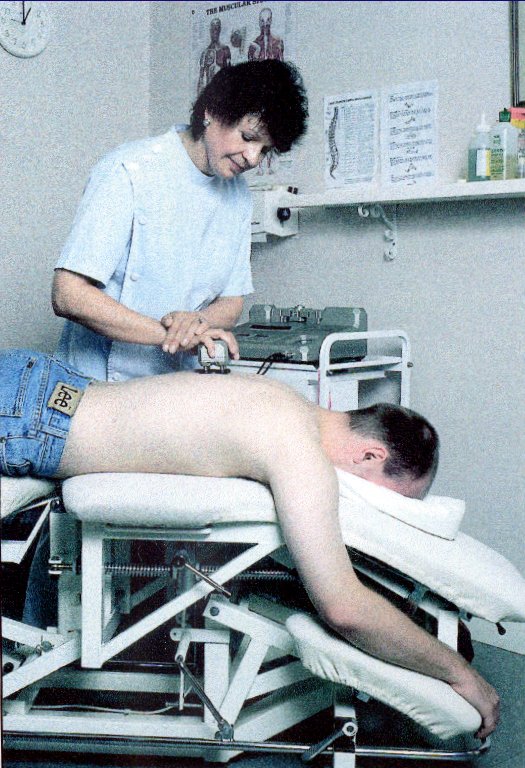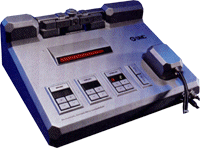As published in Positive Health Magazine
Issue 29 June 1998
The P.A.M. 'bionic handset'
incorporates 4 pads operated by 4
pneumatic pistons which are synchronised so as to operate
in opposing pairs, following the line of the spine.
Back Pain – An Ever Increasing Problem
Why has back pain become a major problem? The
treatment of back pain is a growth industry, yet the
statistics and research indicate that the back problem is
not being adequately solved, even though some therapies
have gained a reputation on their successes for reducing
back pain. The statistics get higher every year: 14
million visits to the doctor each year, costing the
health service £480 million. £5 billion is annually
lost to industry because of the 120 million days taken
off sick by back pain sufferers. The results of
treatment, by whichever therapy are usually short lived,
because manual therapy cannot get to the underlying cause
of the problem, and prognosis is similar with or without
treatment.
Using this new technology, I
have found that people who have had idiopathic back pain
for up to 30 years have found that their pain has
disappeared. They find it very hard to believe, and think
the treatment is "a miracle". They have usually
tried every type of treatment. These chronic cases have
often given up hope of recovery and attend the last
resort – the Pain Clinic. Because the equipment
exercises both the vertebrae and stimulates the spinal
reflexes to stress relieve the spine, it is now possible
to treat both simple and complex mechanical back
problems.
A Typical History of Low Back Pain
Most back pain builds up
through years of misuse of the spine. Most readers will
recognise the following stages and symptoms that occur
during bouts of back pain. Traumas such as whiplash may
create stiffness in certain joints, and other joints
compensate and become over-stressed. This leads to the
symptoms of inflammation, stiffness and muscle spasm
which cause pain.
Stage 1 –
The lower back is usually the first to complain of
over-stressing. The patient may experience a few twinges
or the sudden onset of debilitating pain and it might
occur when the patient is doing a low gain activity, like
bending to pick up soap in the shower. The patient may
appear to make a recovery, with or without treatment.
Over time, the problem may reoccur set against a
background of back-ache and morning stiffness.
Stage 2 –
Here the affected joint shows the classic signs of
excessive wear and tear and disc degeneration. The joints
are vulnerable at the concentration of stresses in the
spine, mainly in the curve of the neck and low back. The
patient may complain of restricted movement and pain.
They may feel they have to give up hobbies which
aggravate their condition, such as gardening, tennis,
squash, golf or even their career.
Stage 3 –
The stresses in the spine continue and may result in a
prolapsed disc. It may be at this later stage they go and
see a therapist who might give them instant relief.
However, unless suppleness and elasticity can be brought
back to the spine, the relief may be temporary and the
over stressing of joints continues.
Stage 4 –
The patient becomes old before their time and avoids
activities that aggravate the problem. They may not be
able to sit or stand for long. Life is generally full of
pain and not much fun for them or their family. By this
stage they may be on disability benefit.
The Solution
To function efficiently the
spine must be supple and elastic like that of a healthy
teenager. Until the development of PAM there was no
mechanism to restore supple elasticity in the spine.
Using a combination of three modes, the therapist can
work the "bionic handset" throughout the length
of the spine exercising each vertebrae and stimulating
the spinal reflexes. The approach is both logical and
safe, and even enjoyable for the majority of patients.
Even at stage 4, improvements can be made. However,
treatment should be ideally commenced before there is a
problem.
As an osteopath I firmly believe
in the osteopathic principle "Structure governs
function." In simple terms this means, if there is
something wrong with the structure of the body it will be
in a state of dis-ease and therefore not function at its
optimum level. If an anatomical structure such as the rib
cage is unequal, this may place strain on the organs
within that structure, i.e. heart or lungs. This may lead
to disease of those organs. Abnormal curvatures of the
spine such as scoliosis (S curve) can now be reduced
using this treatment, avoiding the need for braces or
surgery; whiplash can be treated immediately; the
stresses in the spine which caused a prolapsed disc can
be reduced. I have found that my own practice has
changed, as more complex cases present themselves for
treatment. Patients who have had surgery can also benefit
from this treatment, as the stresses which caused their
original problem in the spine will not have been removed
by surgery; any fusions will cause a new stress.
Treatment with PAM.
Each spine is different. The
number of treatments required will depend on the patients
age and suppleness, but on average 3-5 sessions will
restore supple elasticity. As with all physical
therapies, a full case history and examination of the
patient is carried out to eliminate any possible
pathological problems. There are very few contra
indications for using PAM making it safe to use with
osteoporosis, fusions or prolapsed discs.
Treatment is carried out with
the patient lying face down on the couch whilst the
therapist moves the "bionic" handset throughout
the length of the spine, observing the subtleties of
mobility and stresses within the spine. The handset
incorporates four pads, operated by four pneumatic
pistons. These pistons are synchronised so as to operate
in opposing pairs. The pads are spaced so as to
correspond with the levels of vertebrae.
There are three modes of
operation: spasm, reflex and mobilisation. Spasm prepares
the muscles and commences and ends each treatment; reflex
mode stimulates the spinal reflexes which stress relieves
the spine and mobilisation mode improves the mobility of
the spine by counter-rotating one vertebra on another.
With a combination of these modes, there are very few
spines which cannot be quickly and efficiently restored
to supple elasticity. The patient's responsibility is to
walk tall for ten minutes a day for 10 days to exercise
the postural muscles.
As well as the reported relief
of back pain, many patients have stated other benefits,
such as an improved sense of well being, reduction in
headaches, reduction in irritable bowel symptoms,
increases in height and improved posture.
Prevention
The ideal situation is for
the patient to receive treatment before reaching the
final stages of back pain. Preventative treatment should
be encouraged from an early age like a routine dental
check up, so that back pain is avoided in later life. A
small price to pay for a healthy spine. Such an MOT may
require a yearly visit. Older patients and active sports
people may require treatment up to 4 times a year.
Although this treatment is
suitable for straightforward simple back problems, I have
found this method particularly useful for abnormal
curvatures such as dowager hump, scoliosis, pectus
excavatum (funnel chest), chronic back pain and whiplash.
Conclusion
Up until now there has been no really effective way to cure back pain, or change abnormal spinal curvatures. This new treatment brings all manual therapy into the 21st century, because many of the techniques currently used have not changed since the early 1900s, and have not got to grips with the mechanics of the problem. Power Assisted Micro-Manipulation is a simple solution for a simple mechanical problem.
About the author
Irene Phillips is a practising osteopath with a particular interest in classical and cranial osteopathy. She also has a psychology, counselling and training background. For further information about this treatment, please send sae to Irene Phillips, The Back Care Clinic, 1a Station Approach, Worcester Park, Surrey KT4 7NB. She can be contacted on Tel: 0181-335 3787
| BACK TO HOME PAGE |
1. Minor scoliosis and neck
injury.
Patient TH, a
female aged 24 presented with neck and shoulder pain
which she had suffered with since the age of nine, when
she fell forward off a swing and hurt her neck. She also
had 1–2 headaches weekly. She had received regular
chiropractic care since the accident. On her first
treatment using PAM the scoliosis disappeared and her
pain levels were reduced. She reported at the second
treatment that she had not had any headaches and was
feeling more flexible. Treatment was given on a weekly
basis and following her third treatment, she phoned
saying she could not believe that she was totally pain
free for the first time ever.
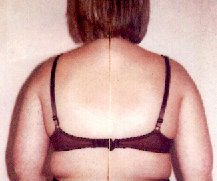
Whiplash patient prior to treatment.
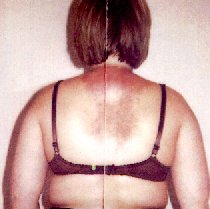
After 1 treatment.
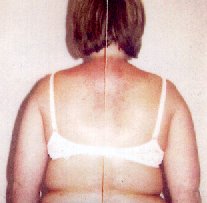
After 2 treatments.
2. Whiplash
Patient TC, a
female aged 23 presented at the clinic with low back and
neck pain and twice weekly headaches following a whiplash
injury 18 months previously. She had a high level of
subjective pain, limited forward and side bending,
restricted cervical rotation and forward bending. She had
a pronounced dowager’s hump. She had no previous
history of back pain prior to the accident. She had
previously received a short course of physiotherapy at a
local hospital, which had mainly consisted of exercises.
On her
second visit she stated the headaches and pain had
reduced. Following the second treatment, her neck length
had improved once more and she left the clinic pain free.
The visual change in anatomical structure was almost
immediate, yet this result could not be achieved by
manual methods.
